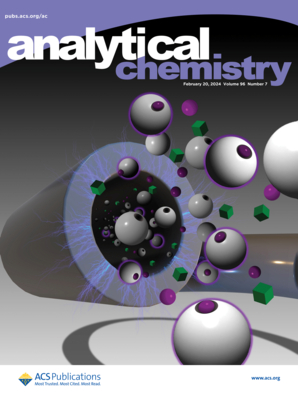Collaborative Internal Cavity Effect and Interfacial Modulation Mechanism for Boosting Deep Learning-Powered Immunochromatographic Pathogen Detection.
IF 6.7
1区 化学
Q1 CHEMISTRY, ANALYTICAL
引用次数: 0
Abstract
Nanoenabled immunochromatographic assay (ICA) emerges as a powerful tool for pathogen diagnosis, yet current nanotechnologies are still constrained by inadequate light-matter interaction efficiency, sluggish nanomaterial flow dynamics, and inefficient immunorecognition. Herein, we present a deep learning-enhanced immunoassay synergistically leveraging the internal cavity effect of hollow carbon nanospheres (h-CNSs) and interfacial antibody orientation modulation for the ultrasensitive detection of S. typhimurium. The h-CNSs exhibit significantly enhanced light absorption (molar extinction coefficients 5.4 × 1011 vs. 3.7 × 1011 L mol-1 cm-1 for counterpart) and photothermal conversion efficiency (66.78% vs. 43.37%) due to internal light reflection within the hollow cavity, while the reduced density (0.05 g mL-1) optimizes lateral flow kinetics. Further interfacial modification with 3,5-dicarboxybenzeneboronic acid enables directional antibody immobilization through boronate affinity, improving antibody binding affinity by 83-fold (Ka = 2.95 × 109 vs. 3.55 × 107 M-1). Integrated into an ICA, D-h-CNSs achieve visual detection limits of 500 CFU mL-1 (colorimetric) and 100 CFU mL-1 (photothermal), surpassing conventional ICA (104 CFU mL-1) and demonstrating high specificity, robust stability, and reliable performance in spiked milk and lettuce. By integration with a convolutional neural network (CNN), the developed nanoplatform achieves 100% accuracy for S. typhimurium detection with augmented training, providing a paradigm for amplifying biosensing signals through nanomaterial design and intelligent data analysis.协同内腔效应和界面调制机制促进深度学习免疫层析病原体检测。
纳米免疫层析分析(ICA)作为一种强大的病原体诊断工具出现,但目前的纳米技术仍然受到光物质相互作用效率不足、纳米材料流动动力学缓慢和免疫识别效率低下的限制。在此,我们提出了一种深度学习增强的免疫分析方法,协同利用中空碳纳米球(h-CNSs)的内腔效应和界面抗体取向调制来超灵敏检测鼠伤寒沙门氏菌。h-CNSs的光吸收(摩尔消光系数5.4 × 1011 vs 3.7 × 1011 L mol-1 cm-1)和光热转换效率(66.78% vs 43.37%)显著增强,这是由于中空腔内的内部光反射,而降低的密度(0.05 g mL-1)优化了横向流动动力学。用3,5-二羧基苯硼酸进一步修饰界面,通过硼酸亲和力实现定向抗体固定,将抗体结合亲和力提高83倍(Ka = 2.95 × 109比3.55 × 107 M-1)。集成到ICA中,D-h-CNSs达到了500 CFU mL-1(比色法)和100 CFU mL-1(光热法)的视觉检测限,超过了传统ICA (104 CFU mL-1),并且在加标牛奶和生菜中表现出高特异性,强大的稳定性和可靠的性能。通过与卷积神经网络(CNN)的集成,所开发的纳米平台通过增强训练实现了鼠伤寒沙门氏菌检测的100%准确率,为通过纳米材料设计和智能数据分析放大生物传感信号提供了范例。
本文章由计算机程序翻译,如有差异,请以英文原文为准。
求助全文
约1分钟内获得全文
求助全文
来源期刊

Analytical Chemistry
化学-分析化学
CiteScore
12.10
自引率
12.20%
发文量
1949
审稿时长
1.4 months
期刊介绍:
Analytical Chemistry, a peer-reviewed research journal, focuses on disseminating new and original knowledge across all branches of analytical chemistry. Fundamental articles may explore general principles of chemical measurement science and need not directly address existing or potential analytical methodology. They can be entirely theoretical or report experimental results. Contributions may cover various phases of analytical operations, including sampling, bioanalysis, electrochemistry, mass spectrometry, microscale and nanoscale systems, environmental analysis, separations, spectroscopy, chemical reactions and selectivity, instrumentation, imaging, surface analysis, and data processing. Papers discussing known analytical methods should present a significant, original application of the method, a notable improvement, or results on an important analyte.
 求助内容:
求助内容: 应助结果提醒方式:
应助结果提醒方式:


